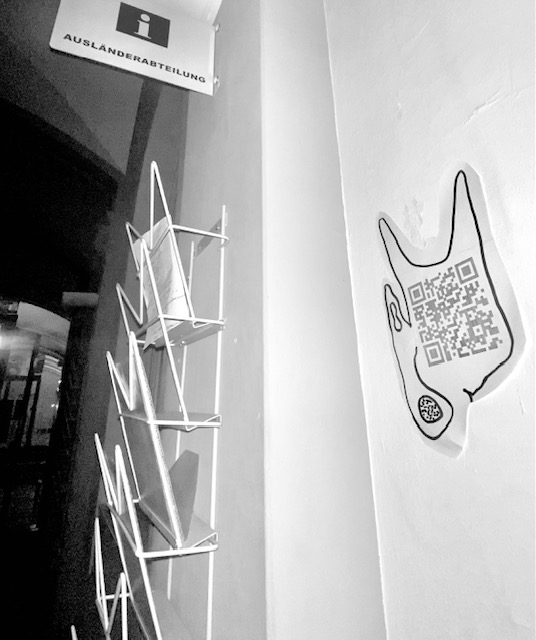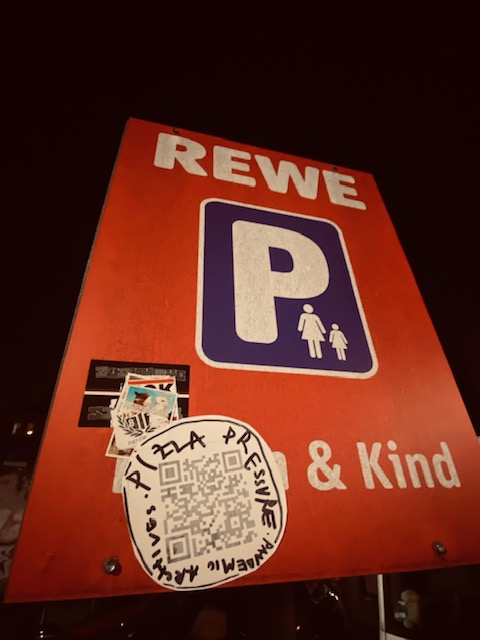References:
- Günter Gaus im Gespräch mit Hannah Arendt, 28. Oktober 1964,https://www.youtube.com/watch?v=dVSRJC4KAiE, min.71, free translation
- Future Histories, Henrike Kohpeiß im Interview on Henrike Kohpeiß- Bürgerliche Kälte Affekt und koloniale Subjektivität, Campus 2023 https://www.youtube.com/watch?v=R0wazWoAKfA, free translation
- Sennett, Richard. (2020). The Public Realm. 10.4324/9781003021391-3., and Together: The Rituals, Pleasures, and Politics of Cooperation. New Haven, Conn.: Yale University Press, 2011.
- Omar Nagati, https://www.adk.de/en/projects/2016/fights-and-fictions/bio/omar_nagati.htm
- Patricie C. Philips, 1989, "Temporality and Public Art", Art Journal, Vol. 48, No. 4, Critical Issues in Public Art (Winter, 1989), pp. 331-335
- Furedi F. Social Distancing, Safe Spaces and the Demand for Quarantine. Society. 2020;57(4):392-397. doi: 10.1007/s12115-020-00500-8. Epub 2020 Jul 19. PMID: 32836556; PMCID: PMC7369440.
The public risk seems clear to me. You expose yourself in the public eye, as a person. [..]The second risk is: we start something, we thread our thread into a web of relationships. We never know what will come of it. We all need to say: Lord, forgive them for what they do, for they do not know what they do. This applies to all actions. [..] I would say that this risk is only possible with trust in people. That is, with a trust in the humanity of all people that is difficult to define precisely but fundamentally. You couldn't do it otherwise.1
Hannah Arendt
[Das Wagnis der Öffentlichkeit scheint mir klar zu sein. Man exponiert sich im Lichte der Öffentlichkeit, und zwar als Person. Wenn ich auch der Meinung bin, daß man nicht auf sich selbst reflektiert in der Öffentlichkeit erscheinen und handeln darf, so weiß ich doch, daß in jedem Handeln die Person in einer Weise zum Ausdruck kommt wie in keiner anderen Tätigkeit. Wobei das Sprechen auch eine Form des Handelns ist. Also das ist das eine. Das zweite Wagnis ist: Wir fangen etwas an, wir schlagen unseren Faden in ein Netz der Beziehungen. Was daraus wird, wissen wir nie. Wir sind alle darauf angewiesen zu sagen: Herr vergib ihnen, was sie tun, denn sie wissen nicht, was sie tun. Das gilt für alles Handeln. Einfach ganz konkret, weil man es nicht wissen kann. Das ist ein Wagnis. Und nun würde ich sagen, daß dieses Wagnis nur möglich ist im Vertrauen auf die Menschen. Das heißt, in einem – schwer genau zu fassenden, aber grundsätzlichen – Vertrauen auf das Menschliche aller Menschen. Anders könnte man es nicht.]
The Corona pandemic began in Hamburg in March 2020, I had just moved in with a large group of people and had a high-risk person in my family. I began to ask myself whether it was just me, who was questioning public encounters to this extent- this constant feeling of checking, comparing myself, having to reinvent norms and wondering whether the people around me are doing the same, whether they also have to be considerate, whether they calculate days between encounters etc. I was sometimes feeling uncomfortable, but not wanting to let situations escalate. I remained still and developed a kind of individual approach to each and every new upcoming situation, constantly asking myself: How can I now be relaxed and responsible at the same time? What am I ok with, what is the other person ok with? Sometimes I felt weird when I had to hide either my caution or my laxity. Simply because they would have been difficult to put into one single sentence. But hiding isolated me in my bubble even more in those days. So at some point I gradually started conversations about all this Covid related ‘internal weirdness’. Richard Sennett famously said ‘The public realm is the place where strangers meet’.3 ( Senett, 2020) He spoke of the need to meet strangers in order to educate oneself, to grow up from a state of adolescence in the friction of encountering different positions, or in other words: to leave ones bubble. Back in those days we were of course still pre-pandemic. Sennett moaned the fact that cities become bubbles of merely homogenous neighborhoods. He claimed that the segregated groups needed to be mingling again to create life in an otherwise dead city, that public space needed to be refilled with people of different backgrounds, circumstances and situations in order to train mutual understanding and empathy and to avoid distance."In principle society's reclamation of public sphere is a necessary means to reboot democracy." Cairo based architect and urban planner Omar Nagati states. "Art intervention in public space”, he suggests, “work[s] through the cracks of the system, both geographically and politically, using design as a negotiating tool, and subversive tactics to mediate the different forms of exclusion resultant from the periods of flux and of securitisation."4 According to Patricia Phillips, artistic works in public space reflect a "social desire for an art that is contemporary and timely, that responds to and reflects its temporal and circumstantial context."5 My conversations about pandemic-related internal weirdness turned into work as part of my master's degree at Fontys university. I started questioning people schematically using a questionnaire/’psycho- test’, and finally I moved on to interviewing people about their experiences while interacting with strangers in public space: The Pandemic Archives. Sociologist Frank Furedi writes about the pandemic times: “In the contemporary world, social distancing and the quest for safe space has acquired a hyper-individualistic form.”6 ( Furedi, 2020) Due to social distancing as enforced by the state and advised by scientists for health reasons, fear of the ‘other’ as a potential threat to one’s own health grew as a form of repercussion. Whereas the term safe( r) spaces was in the first place evoked to create a setting for the (self-) protection of vulnerable groups, it became a phenomenon of an inverted quarantine for individuals in COVID times. In order to pinch the bubbles people had created around themselves I transferred the contents of the interview into textbits, stories and reflections. These texts became an album of spoken word: The Pandemic Archives. I left them in the places where they happened, in the city of Hamburg, accessible via QR code on stickers and in picture frames so that passers-by could access the pandemic archive stories on Soundcloud. My intent was to facilitate insights into each others' perspectives.My attempt was affectization by staging audio experiences that allow the listener to develop an understanding of someone else's perception of the same place/ route/ circumstance in a different time.
With the dissolution of social distancing and the dissipation of the pandemic, my interest has moved towards the research of so-called European‘bourgeois coldness’, a term coined by Henrike Kohpeiß. It describes the enabling of western citizens to remain in a security cocoon of coldness towards people in distress. My research focuses on how to artistically confront this phenomenon of distance.
Adressing this, according to Kohpeiß, the question in Europe must be: “How can we generate participation without questions of identity […] taking over and […]bourgeois identity always being the basis on which this( participation) can be organized? “Who has what right to life, who is heard..?” She continues to question how we will become “a society that can admit that we are deeply affectively linked and can organize coexistence based on this," and she promotes balancing the social techniques of cold and heat: “Where does cold become an authority and warmth a fetish. And how can we avoid both?”
We live in a time when it is common for the bubbles lying beneath the surface to merge into a large movement that is taken by the international right. I believe individual bubbles can only be addressed and made permeable through mutual understanding in Europe and beyond.
According to Kohpeiß the medicine from the situation, i.e. looking for healing perspectives in living together, would be to learn to live without resentment: In this society that is so professional at claiming bourgeois coldness as a progressive way of life, where are those who are marked as disposable lives, where does the self-righteousness come from to do that? Where are the resentments?2 In 2024 I will be developing this new project, with my new collective súper and associated artists: Salon Europa. We want to open a dialogue between differing communites about what concerns them, what values we actually rely on and how people want to practice democracy. We want to connect different bubbles. We plan to create a format that gives people insights into the reality of others. Based on the idea of the city salons of other centuries, we want to bring European communities together in live meet-ups and digital interaction. Simultaneous happenings of salons are created at opposite poles: e.g. in Brussels and inan Irish village, or in Hamburg and on Lampedusa. After a local start and meet up, each with an artistic impulse, participants later on meet individually online with someone from another community/bubble and return to their local group afterwards. We hope for insights around the topics of: What is discussed and what is assured? What does the salon offer space for? What is acceptable in the Salon of Europe?
“How can we generate participation without
questions of identity […] taking over and […] civic identity always being the basis
on which participation can be organized. “Who has what right to life, who is heard..?”2
Henrike Kohpeiß
„wie können wir Mitbestimmung generieren ohne dass Identitätsfragen […] übernehmen und […] bürgerliche Identität immer die Basis ist auf der das organisiert werden kann..
„wer hat welches Recht auf Leben, wer wird gehört..“


